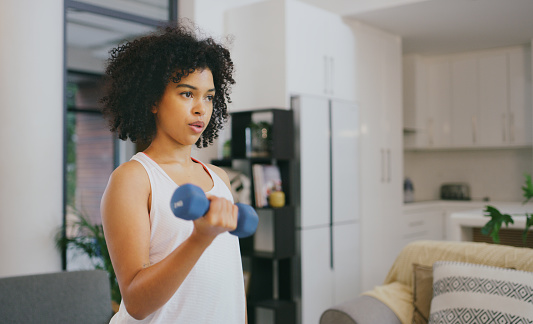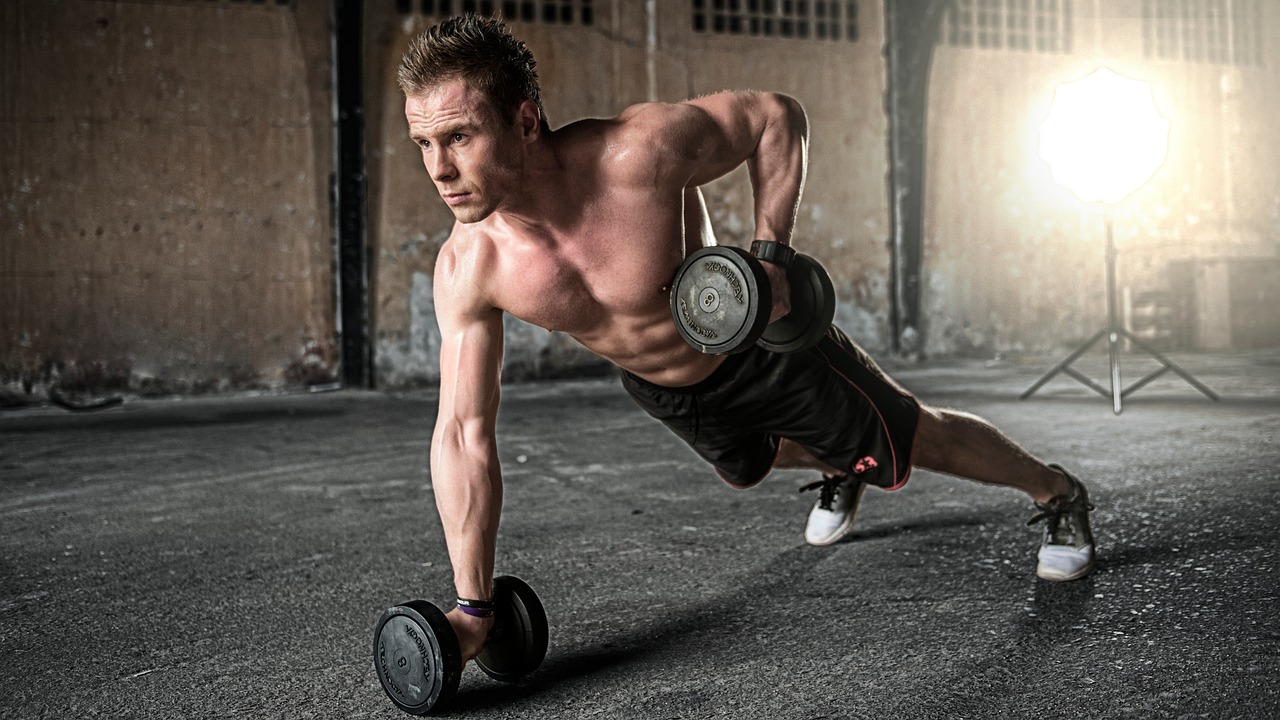In the current era, where convenience blends with fitness ambitions, working out at home has surged in popularity. Among the most versatile and effective tools for at-home workouts are dumbbells, offering a wide range of exercises to target every major muscle group. This guide is crafted to introduce you to the best workouts you can perform within the comfort of your home using just dumbbells. Whether you’re aiming to tone your body, build muscle, or improve endurance, this compilation is designed to cater to various fitness levels and goals. With detailed explanations and a focus on form, we’ll ensure you get the most out of each session, transforming your home into a powerful gym substitute. Let’s embark on this journey together, challenging ourselves and embracing a healthier lifestyle one dumbbell workout at a time.

Diving into the world of dumbbell workouts, the beauty lies in simplicity and adaptability. Dumbbells, unlike many other workout tools, offer unparalleled versatility without requiring a significant investment or much space. From beginners to seasoned athletes, everyone can tailor their training sessions with these handy weights to target strength, endurance, or even flexibility. This guide will demystify the process, presenting a curated list of exercises that will engage your body in entirely new ways. Prepare to explore routines that combine compound movements for full-body engagement and isolation exercises for focused muscle development. Whether your goal is to sculpt your physique or boost your overall health, our comprehensive approach ensures you have all the tools needed for effective home workouts with just a pair of dumbbells at your disposal.
What is the best way to warm up your muscles?

Warming up your muscles before diving into a workout is a crucial step that bridges the gap between rest and physical exertion, priming your body for peak performance while minimizing the risk of injury. The best way to warm up involves starting with dynamic stretches and light aerobic activities that increase your heart rate and blood flow to the muscles. This could include exercises such as jogging in place, jumping jacks, arm circles, leg swings, or even a brisk walk. These movements help to gradually boost your body’s core temperature and enhance muscle elasticity, which is vital for executing more strenuous movements effectively during your workout. Aim for a warm-up duration of about 5 to 10 minutes, ensuring it’s comprehensive and targets all major muscle groups. This not only prepares your muscles physically but psychologically readies you for the workout ahead, setting a solid foundation for any exercise routine.
Following the initial phase of warming up, incorporating specific movements that mirror the workout ahead can further optimize your preparation, especially when planning to engage in weight lifting or intensive strength training. For instance, if your session includes exercises like squats or dumbbell presses, performing these actions with very light weights or no weight at all helps acclimate your muscles and joints to the movements. This technique, known as movement-specific warm-up, allows you to fine-tune your form and increase coordination, ensuring that by the time you proceed to the main workout, your body is not only warmed up but also specifically primed for the exercises you plan to undertake. Remember, the objective of a thoughtful warm-up routine goes beyond mere physical readiness; it’s about mentally setting the stage for a successful and injury-free workout.
Here are the Best workouts at home with dumbbells
Dumbbell Squats
Dumbbell squats stand out as a superior exercise for those looking to engage and enhance their lower body strength comprehensively. This dynamic movement not only activates the major muscle groups in the legs—such as the quadriceps, hamstrings, and gluteus muscles—but it also recruits your core muscles for stability, making it an all-encompassing workout. When performing this exercise, you will start by selecting dumbbells of appropriate weight that challenge you without compromising your form. Each dumbbell should be held firmly at your sides or elevated to shoulder level, depending on your comfort and experience level.
Position your feet shoulder-width apart to ensure a stable base. This stance is crucial as it affects the efficacy of the workout and helps prevent injury. From this starting position, you initiate the squat by bending at the knees and hips simultaneously, as though sitting back into an invisible chair. It’s important to keep your back straight and chest up during this motion to maintain proper alignment. Lower your body until your thighs are parallel with the floor or as close to that position as comfortable, ensuring that your knees do not extend past your toes. This depth maximizes engagement in the targeted muscle groups while safeguarding against strain.
After reaching the bottom of the squat, press through your heels to return to a standing position, driving the movement from your quads and glutes. This upward phase is just as crucial as the descent—control is key, allowing for muscle engagement throughout the entire range of motion. The elevation brings you back to where you started, ready for another repetition.
Dumbbell squats are celebrated for their versatility and effectiveness. Regardless of whether you’re a seasoned athlete looking to bolster your leg day routine or someone embarking on their fitness journey seeking foundational strength exercises, incorporating dumbbell squats can contribute significantly to achieving those fitness milestones while promoting overall muscular balance and posture improvement.
Bench Press

The bench press is a quintessential exercise tailored for those eager to sculpt and strengthen their upper body, specifically targeting the chest, shoulders, and triceps. This potent movement not only helps in building muscle mass but also enhances upper body strength like few other exercises can. To embark on this exercise, you will need a set of dumbbells and a bench or any stable flat surface that can support your back comfortably during the workout.
Begin by lying down on the bench with your eyes aligned under the weights to ensure proper positioning. Grasp a dumbbell in each hand with a grip that feels secure yet comfortable. Your arms should be positioned out to the sides of your body, creating an angle of about 90 degrees at your elbows; this is your starting point. Pushing through the palms of your hands, elevate the weights upward in a smooth, controlled motion until your arms are fully extended above you. It’s crucial during this phase to maintain a slight bend in your elbows to avoid locking them out completely, which can put undue stress on the joint.
After reaching full extension, pause momentarily at the top to engage and activate the muscles targeted even more intensely. Following this brief pause, initiate the return phase by gently lowering the dumbbells back down towards chest level. This downward movement should be performed slowly and deliberately to maximize muscle tension and reap full benefits from the exercise. Ensure that during this descent, you keep control over the movement paths of both arms — they should remain symmetrical and move at an even pace.
The elegance of the bench press lies in its comprehensive approach to developing upper body strength by meticulously engaging multiple key muscle groups simultaneously. Whether you’re aiming for aesthetic improvements like muscle definition or focusing on functional gains such as increased pushing power, integrating bench presses into your workout regimen can significantly propel you toward those fitness milestones. By adjusting weight according to ability while focusing on form and technique precision, practitioners from all fitness backgrounds stand to gain immensely from this time-honored exercise staple.
Dumbbell Rows
Dumbbell rows stand out as a highly effective exercise tailored specifically for strengthening and defining the back muscles along with the biceps. This targeted workout not only promotes muscle growth in these areas but also aids in improving overall posture and spinal stability. Performing dumbbell rows requires a bench or any sturdy platform that can support your weight comfortably, ensuring a safe and productive workout environment.
To begin this exercise, position yourself beside the bench, placing one knee and the hand of the same side on it for foundational support. It’s crucial to keep your back straight and parallel to the ground, creating an optimal stance for engaging the muscles accurately. In the opposite hand, grasp a dumbbell with your palm facing towards you; this is your starting position. Ensure that your grip is secure yet comfortable to facilitate a fluid motion throughout the exercise.
Initiating the movement, engage your core and smoothly lift (or ‘row’) the dumbbell upwards by bending at the elbow and pulling it towards your torso. As you perform this upward rowing action, concentrate on squeezing your shoulder blades together to maximize engagement of the back muscles. The elbow should be kept close to the body during this phase to effectively target the intended muscle groups without straying energy.
Once you’ve reached the peak of this rowing motion—wherein the dumbbell aligns closely with your torso—allow yourself a brief moment to ensure that you’re fully contracting your back muscles and biceps. Following this, gradually lower the dumbbell down to return it to its original starting position beneath you. This descent should be controlled and measured, preventing any sudden drops that could potentially lead to strain or injury.
Dumbbell rows are celebrated for their profound impact on muscle definition and strength in both the back and biceps. By meticulously practicing this compound movement, enthusiasts can achieve significant muscle gains while enhancing their body’s structural integrity through reinforced back musculature and improved posture alignment. Incorporating dumbbell rows into your fitness routine will undeniably serve as a cornerstone workout for those dedicated to building a stronger, more resilient upper body.
Dumbbell Lunges

Dumbbell lunges are a highly efficient, multi-joint exercise that targets and tones multiple muscle groups simultaneously, making them a staple in strength training routines. The beauty of dumbbell lunges lies in their simplicity and the profound impact they have on the legs and core, offering both strength development and improved balance. This versatile workout engages the hips, glutes, quadriceps, hamstrings, and core muscles with each repetition.
To execute dumbbell lunges properly, start by standing tall with your feet hip-width apart, holding a dumbbell in each hand by your sides. This starting position is crucial as it sets the tone for your posture throughout the exercise. Ensuring that your spine remains neutral, take a measured step forward with one leg. As you do so, bend both knees to lower your body towards the floor.
The key is to descend until your front thigh is almost parallel to the floor and your back knee hovers just above it. In this bottom position of the lunge, there’s a significant engagement of the front leg’s quadriceps and glutes along with an active stretch in the rear leg’s hip flexors and hamstrings. Meanwhile, holding the dumbbells at your sides challenges your core to stabilize your body throughout this dynamic movement.
After reaching the depth of the lunge, focus on pushing off with your front foot to return to the starting stance. It requires activating those same working muscles – quads, glutes, hamstrings – in reverse order to lift yourself back up. Ensuring this push-back phase is executed with control not only enhances muscle engagement but also prevents undue stress on the joints.
Proceed to alternate legs with each repetition, maintaining a continuous movement pattern that ensures both sides of the body are worked evenly. Dumbbell lunges are not merely about lowering and lifting; they’re about stability, balance, and coordination – all fostered while under load due to holding onto weights.
Incorporating dumbbell lunges into your home workout regimen can significantly enhance muscular strength and endurance while cultivating balance and agility. As simple as they may seem at first glance, when performed correctly these exercises are profoundly beneficial for achieving overall lower body fitness and core stability.
Shoulder Press
The Shoulder Press is a quintessential exercise targeting the shoulders and triceps, renowned for its effectiveness in building upper body strength and sculpting muscular definition. This versatile movement can be performed either seated or standing, accommodating various fitness levels and preferences. Engaging not just the primary muscles, the exercise also subtly recruits the core for stability, making it a comprehensive upper body workout.
To begin this exercise, position yourself with a firm base; if standing, your feet should be shoulder-width apart to ensure balance. Holding a dumbbell in each hand, elevate your arms to shoulder level with your palms facing forward. This starting position primes your muscles for the work ahead.
As you initiate the movement, concentrate on pressing the dumbbells upward directly above your head. The motion should be fluid and controlled to maximize muscle engagement without compromising form. Your arms should extend fully at the peak of the lift but avoid locking out the elbows completely; this maintains tension in the muscles and prevents joint strain.
Once reaching full extension, take a brief moment to stabilize before embarking on the descent back to shoulder height. The lowering phase of this exercise is equally important as it engages muscle fibers under tension, promoting strength gains. It’s crucial during this phase to control the weights carefully rather than allowing gravity to dictate the pace.
Beyond merely enhancing shoulder and tricep strength, performing Shoulder Presses can lead to improved posture thanks to strengthened support muscles around the shoulders and upper back. For those seeking an integral component for their upper body regimen, incorporating Shoulder Press exercises offers not only aesthetic benefits in muscular definition but also functional improvements in daily activities requiring pushing motions.
Throughout this exercise, maintaining proper form is paramount—a straight spine and engaged core will not only optimize muscle recruitment but also minimize injury risks. Regardless of whether one opts for standing or seated variations, consistent practice of Shoulder Presses will pave the way towards achieving both strength objectives and broader fitness goals.
Bicep Curls

Bicep Curls stand out as a focused and highly effective exercise specifically designed to sculpt and strengthen the biceps, which are principal muscles of the upper arm. This workout is fundamental for anyone looking to enhance arm muscle definition and increase upper body strength. The simplicity of bicep curls makes them an accessible exercise for both beginners and advanced athletes, allowing for variations in weight to match an individual’s fitness level.
To execute a proper Bicep Curl, begin by positioning yourself with your feet set shoulder-width apart. This stance provides a stable foundation and helps prevent any unnecessary swaying that could detract from the effectiveness of the exercise. In each hand, grasp a dumbbell with your palms facing outward, away from your body. This grip engages the bicep muscles right from the start.
With your elbows close to your torso, initiate the curl by bending at the elbow and lifting the weights towards your shoulders. It is crucial during this phase that you keep your upper arms stationary; only your forearms should be moving. By isolating the movement to just the forearms, you ensure that your biceps are doing the bulk of the work and receiving maximum benefit from each curl.
As you lift, focus on maintaining a controlled motion without utilizing momentum or swinging the weights. Such discipline in movement ensures that every muscle fiber in the biceps is engaged through tension, fostering better muscle growth and strength development.
Once the dumbbells reach shoulder height—or as close as you can comfortably manage—take a moment to squeeze your biceps at this peak contraction point. This brief pause amplifies muscle engagement further before you slowly lower the weights back down to their starting position.
In addition to building bicep mass and enhancing arm aesthetics, Bicep Curls also contribute to overall upper body strength. As these muscles become stronger through consistent training, they play a more supportive role in various other weight-lifting exercises and daily tasks involving lifting or pulling.
For those committed to developing toned and powerful arms, incorporating Bicep Curls into their routine offers undeniable benefits. By ensuring correct form—keeping those upper arms still throughout—the efficiency of every curl maximizes outcomes in muscular endurance, size, and strength gains.
Tricep Kickbacks
Tricep Kickbacks are a precision exercise, meticulously crafted to sculpt and define the triceps muscles, which constitute the back part of the upper arm. This targeted workout not only contributes to the aesthetic appeal of well-defined arms but also plays a vital role in building strength for various upper body movements. The meticulous nature of Tricep Kickbacks makes them an excellent choice for anyone looking to enhance their arm physique and overall upper body functionality.
To initiate this exercise, one must adopt a starting position that involves leaning forward slightly from the hips. This stance is further stabilized by bending the knees slightly, ensuring that you maintain a good balance throughout the exercise while effectively engaging your core. Holding a dumbbell in each hand, let your arms hang by your side with palms facing each other.
A critical aspect of Tricep Kickbacks is keeping your elbows pinned close to your torso throughout the movement. This positioning is essential as it helps focus the workout intensity on the triceps muscles, maximizing their engagement and growth potential with every repetition.
With your elbows in place, proceed by extending both arms backward until they are parallel with your body. It’s paramount during this extension phase to keep your upper arms stationary; only your forearms should move. Such precision ensures that the triceps are isolated and forced to do the heavy lifting, literally. By stretching and then contracting, these muscles undergo intense work that leads to enhanced muscle definition and strength.
Upon reaching full extension where your arms are parallel to the floor, take a brief moment to focus on contracting (squeezing) your triceps intensely before gently releasing and returning to the starting position.
Tricep Kickbacks serve more than just an aesthetic purpose; they bolster upper body strength significantly. With stronger triceps, you’re better equipped to perform other major lifts and activities requiring pushing motions. Consistently incorporating Tricep Kickbacks into your workout regime can lead to noticeable improvements not just in muscle definition but in overall arm strength and performance as well.
Bent Over Row

The Dumbbell Bent Over Row is a quintessential exercise that targets a wide array of muscles, with a particular focus on the back. This powerful exercise emphasizes the upper and lower back muscles, including the latissimus dorsi, rhomboids, and trapezius. Additionally, it engages secondary muscle groups such as the biceps, shoulders, and even contributes to core stabilization, making it an indispensable component of any strength training or bodybuilding regimen.
To perform this exercise correctly, one begins by selecting an appropriate weight in dumbbells – challenging enough to perform reps with effort but not so heavy that form is compromised. Standing with feet shoulder-width apart provides a stable base. Then, bending forward at the hips while keeping a slight bend in the knees positions the body almost parallel to the ground; it’s crucial here to ensure that the back remains straight and not rounded to avoid strain or injury.
With a dumbbell in each hand (palms facing towards your body), extend your arms downward as you assume the bent-over posture. The lifting phase begins by driving your elbows towards the ceiling while keeping them close to your body. As you pull the weights upwards towards your chest, focusing on squeezing your shoulder blades together will further activate the muscles in your upper back.
This upward rowing motion should be smooth and controlled; rushing through it can lead to momentum taking over, which reduces muscular engagement and effectiveness of the exercise. After reaching the peak contraction point where your dumbbells are near your ribs or chest depending on arm length and flexibility, slowly lower them back down with equal control. This eccentric part of the movement is equally critical for muscle growth and development.
The Dumbbell Bent Over Row stands out for its versatility and accessibility; it can be performed virtually anywhere there’s space for a stance and room to row – no sophisticated gym equipment necessary. Regular inclusion of this exercise into your routines can lead to significant improvements in back strength, posture, and overall upper body muscle definition.
By targeting multiple major muscle groups simultaneously under load, this exercise not only fortifies muscular endurance but also stimulates greater caloric burn due to its compound nature. Thus making it an excellent choice for those aiming to enhance their physical fitness whether their goals are focused on building muscle mass, losing weight, or elevating general health.
Conclusion
In conclusion, incorporating dumbbells into your at-home workout routine offers a flexible, efficient, and effective way to target a wide variety of muscle groups, from the core of your body to its extremities. Exercises like Dumbbell Lunges, Shoulder Presses, Bicep Curls, Tricep Kickbacks, and Bent Over Rows not only showcase the versatility of this simple piece of equipment but also demonstrate how it can be used to achieve comprehensive strength training.
Dumbbells allow for unilateral training which helps in correcting imbalances between the left and right sides of the body and provides a unique challenge to stability and core engagement. The adaptability of dumbbells suits all fitness levels; whether you’re looking to tone up, build muscle mass or improve your overall physical endurance, there’s a variation or weight that fits your needs.
Furthermore, the convenience of working out at home with dumbbells cannot be overstated. It eliminates barriers such as time constraints and the need for expensive gym memberships while offering privacy and comfort – crucial factors in maintaining a consistent exercise routine.
However, as effective as these workouts are, they should be performed with proper technique and progressive overload in mind. This ensures continuous growth without plateauing or risking injury. For those just beginning their fitness journey, starting light and gradually increasing weight can pave the path towards achieving remarkable results.
Ultimately, building a better physique or enhancing one’s health does not necessarily require complex machinery or intimidating gym environments. A pair of dumbbells at home might just be the cornerstone upon which personal fitness goals are achieved, making them an invaluable tool for anyone serious about staying in shape or improving their well-being.
Thank you for reading this article!! I hope this article was helpful. While your at it check out the METIS Chrome Dumbbells Review

